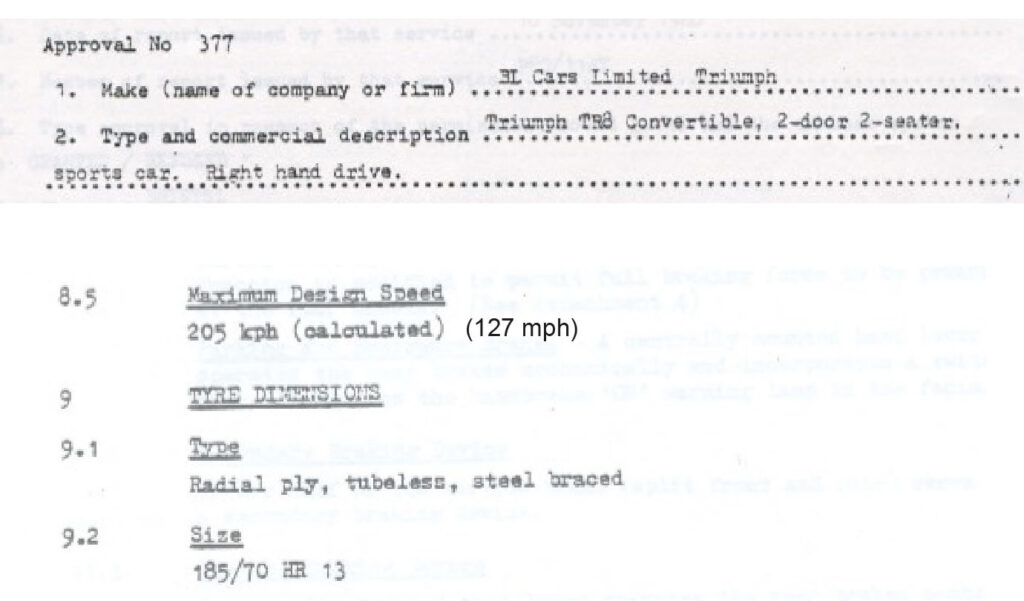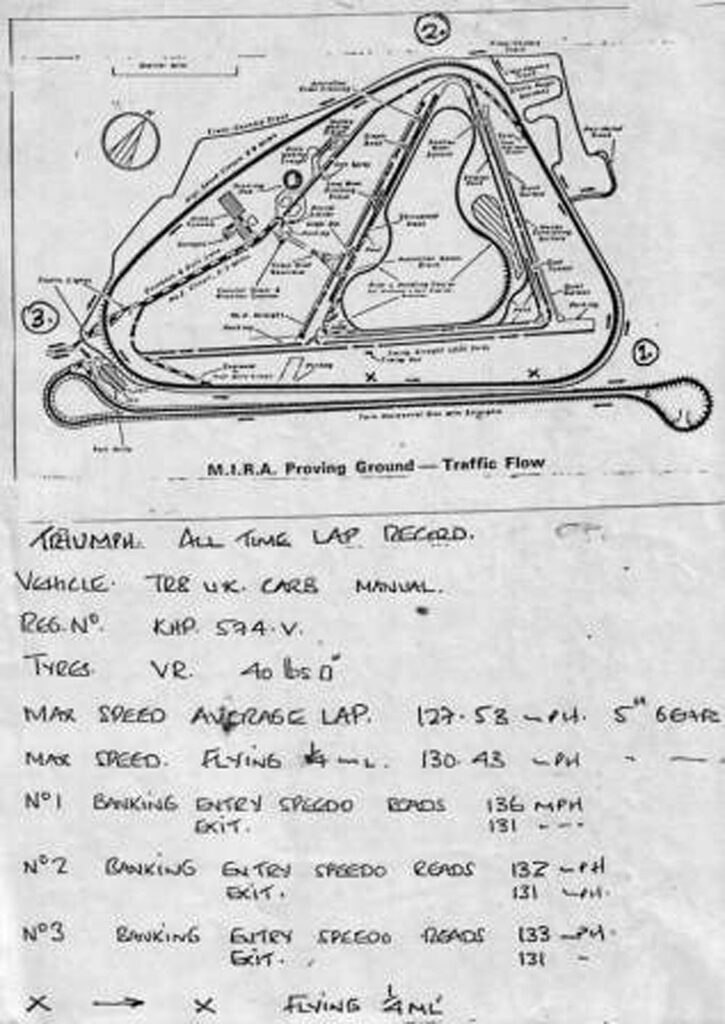TR8 how fast how powerful
TR8 how fast? Claimed Top speed for the different TR8’s varies widely, and some paper work says one thing, and other paperwork something different. So, what is true? To find the answers, we need to stop just being archivists/collectors of records, and become detectives, almost present-day archaeologists if you will as well. In effect we need to work backwards from what is actually still here today in the cars and people still around, before they are gone.
So, in the case of working out TR8 maximum speed what do we know that is fixed? The gear ratios essentially. Beyond that we get a number of variables depending on altitude, flat road, downhill road, temperature, induction system, Friday afternoon car etc.
Earlier and essentially 1980 production TR8’s
| TR8 Up to Vin 402026 | ||
| Miles 5th Gear | Revs K | Speed MPH |
| 26.3 | 1 | 26.3 |
| 2 | 53.6 | |
| 3 | 78.9 | |
| 4 | 105.2 | |
| 5 | 131.5 | |
| RED LINE | 5.5 | 144.65 |
| 6 | 157.8 |
And for later 81 model year TR8’s and a few development and EXP 8’s from 1980
| TR8 from Vin 402027 | ||
| Miles 5th Gear | Revs K | Speed MPH |
| 27.6 | 1 | 27.6 |
| 2 | 55.2 | |
| 3 | 82.8 | |
| 4 | 110.4 | |
| 5 | 138 | |
| RED LINE | 5.5 | 151.8 |
| 6 | 165.6 |
So, if the car had the required power, it would hit those speeds? In theory yes, but in practice no because the stability of the car also affects whether you stay on the road to achieve the top speed or crash off before you reach that speed.
Stability
The type approval document for the RHD TR8 number 377
The paragraph 8.5 is Maximum Design Speed shows the designed top speed as 205kph/127mph. Will the car go past this, yes. Will the car be stable and safe above this almost certainly not unless improvements are made to the car’s stability.
To quote from Richard Hurdwell’s memo December 1980 on the modifications to NWK988W
“A rally TR7 V8 spoiler was fitted, with small modifications to fit under the bumper. This is a GRP moulding made for us by Albert Coates in John Cooper’s ‘Plastics Development’ area at Solihull. The spoiler has proved very robust, but for extra durability a flexible polyurethane moulding was planned for the (now scrapped) 1981 rally TR8. Wind tunnel testing at MIRA during rally car development indicated that this spoiler should reduce front lift by between 10 and 30%. This assists straight line and cross wind stability which was found to be a problem. Engine cooling should also be improved”
So, it was well known the car had straight line and cross wind stability issues at speed which was a problem and no doubt had a bearing on the type approval document design top speed of 127mph.
The Mira test TR8 with a UK spec engine of 153bhp did a 130.43 mph quarter mile (average lap was 127.53mph – very close to the design speed of 127mph) and very briefly hit 137mph on a high speed banked track just once, so had some help from the circuit to achieve that.
That car was fitted with a MK1 rally spoiler so had some help in staying on the road at speed (approximately 10% reduction in lift)
With a modified TR7 V8 but standard setup, personal experience from a trip down the autobahn early one Sunday morning at beyond 130mph confirms it is extremely unstable and far from safe. Bottom line unless you have a death wish 130mph with the standard spoiler is pretty much the limit!
So, any top speed, if the car has enough power, with the standard spoiler fitted is going to be limited to “safely” 127/130mph.
Richard Hurdwell told me last year the standard spoiler is for pushing air into the radiator only, it gives zero assistance to keeping the car on the road as probably do many of the aftermarket spoilers by Rimmers and the like. The ONLY spoilers proven to add assistance in reducing lift, is the MK1 Rally at around 10% plus improvement for reduction of lift and the MK2 at up to around 30%. Both proven in a wind tunnel at Mira.
The only way a standard factory production TR8 can go beyond 127/30mph in a more stable environment is with one of the rally spoilers fitted or similar (preferably the MK2) and other improvements to increase stability. Alternatively in a less stable environment, a driver with a death wish, but then that’s probably going to end up a bit one way or if you are very lucky a huge adrenalin rush! I tried it once and was very lucky, I don’t plan on doing it ever again.
NWK988W was tested to 150mph but this car was fitted with the MK2 rally spoiler and essentially much of the works cars suspension and or similar parts, so a very long way from the standard car.
Claimed top speeds
What is the top speed of a “STOCK FACTORY USA TR8”?
If you Google it 135mph comes up a lot and in one Road and Track article from 1980 it does say their test car reached 135mph. Speedometer readings above 90 mph were never accurate on cars from this era. If you read the road tests of the day, some listed the difference between actual and indicated mph. It is highly likely the TR8 would be at least 10-15 mph optimistic. Also, the top speeds quoted by Road and Track for their standard road test were usually theoretical.
So, can a less powerful USA spec TR8 than the Mira test car with no additional aid to stability reach 135mph? And if not, what is the real top speed? Interestingly the TR Register on their web site have the top speed of the factory USA spec TR8 as 120mph as do a number of TR books. And that given its lower power is where I would expect it to be, with perhaps another few mph so perhaps 125mph. Most likely the specs of the two cars UK and USA have become the same over time with people lazily writing articles and poorly failing to check facts correctly. These facts have then been regurgitated repeatedly in various other articles and so on.
Power USA Efi 137/148 bhp – This has been a question mark for many years with supporters for both and factory documents for both! On the rolling road those cars in the USA that have been tested come out at around 135bhp. Albert Tingley the Lucas engineer who worked on the Efi is adamant that the car was 137bhp and not 148bhp. How ever my own TR8 Efi (Personal Export Derivative – didn’t have to comply with type approval and was registered in the UK before being driven to Germany and delivered to its first owner) was the nearest spec to a European TR8 the factory built in that it left the factory running four-star leaded fuel without cats and had a different ignition system fitted, came out at 143bhp so “perhaps” this was what the European LHD TR8 would have been once the emissions equipment had been removed. The figures for the PED variant would potentially have been known so as marketing obviously preferred a higher number, with an Efi car having achieved it, they used 148bhp perhaps? Still a mystery that one.
So here are my performance figures for the various TR8’s based on what has been written, the actual surviving cars performance, the known stability issues and personal experiences of both myself and many others. I do have a photo of a sat nav proving a USA spec Efi TR8 hit 135 but it also had altitude having a positive effect so more likely 130mph without that advantage. Unfortunately for obvious reasons I can’t show that picture. The Mira car went past 135 but it was on a high-speed circuit which also assisted it and it had more power. So, on the flat as is 130mph I believe is correct particularly with the stability issues added in.
| Model | Power/bhp | 0 – 50 | 0 – 60 | Top Speed |
| TR8 Carburettor USA LHD | 133 | 6.2 | 120/125 | |
| TR8 Efi Model USA LHD | 137/148 | 8.1 | 125/130 | |
| TR8 Carburettor UK RHD | 153 | 7.5 | 127/130 | |
| TR8 Carburettor MIRA RHD | 153 | 7.5 | 137 | |
| TR8 Carburettor NWK RHD | 270 @ wheels | 5.6 | 150 | |
| TR8 Le Mans TWIN TURBO | 500 plus | 201 |
Bottom line for most is a 0 – 60 of 8.1 seconds with a top speed of 125/130 and that perhaps is the fairest assessment for most of the USA/CAN factory production TR8’s.

